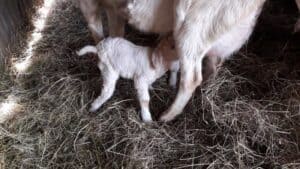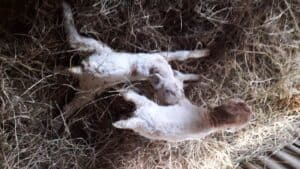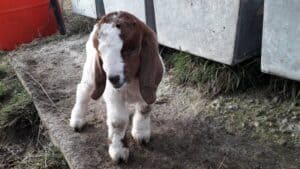This post was most recently updated on September 1st, 2020
If you have noticed that your doe is in early labour, or due to give birth at any moment, here is everything you need to know about got labour and delivery.
Please read: This information is provided for educational purposes only and is not intended to treat, diagnose or prevent any disease. We encourage you to make your own health care decisions in partnership with a qualified health care professional.
This post contains affiliate links, this means at no extra cost to you, we make a commission from sales. Please read our Disclosure Statement
If you need to know what to look for in early labour in goats check out this post.
Early labour signs in goats
Once your doe starts these things, you can expect a baby within the next 12-24 hours. Bring her in close if she isn’t already and check in on her every few hours if you can.
- Pin bone softening
- Leaking from the vulva, or loosing the plug. The discharge often starts clear, then becomes more opaque and thickened as labor progresses.
- Vulva swelling
- Sunken in sides near the hips – the babies have “dropped” or engaged ready to be born
Setting up a birthing suit for a goat
If you can, put your mama goat that is ready to birth in to a warm stall with plenty of clean bedding as soon as you get an inkling that she might be about to give birth.
Goats will naturally go off and hide to have their babies, this can be a concern if you need to help with the delivery, and we have learned first hand the sadness of not knowing when or where the mama is having her baby.
If it is particularly cold at night, a heat lamp can be helpful.
Be sure to have a stash of old towels and some lubricant available in case you need to help dry the babies or reposition them in labour.
Birthing baby kids – delivery time!
When birth starts, the goat might rock a bit and push. She might alternate between standing or lying down.
A bubble filled with liquid will appear from her vulva. This is the amniotic membrane or the water sack. The bubble will come out a little at a time. It might contract slightly after the push is over but it should make progress with each contraction.
You should see two little hooves inside the bubble, then a nose. Sometimes babies are born breech – back feet first.
Clear the nasal passages of the kid as soon as the water sack breaks.
The doe should continue to push and deliver the kid rather quickly. The last of the kid will be delivered swiftly and slides out in one swooshing motion.
What to do if you are there when your goat delivers
Usually a goat will delivery naturally without intervention. The best thing you can do is gather a heat lamp, some dry old towels, gloves and lubricant and just sit and wait and watch.
Your doe will sometimes baa and end with a pushing or straining sound or grunt. A water bubble might be visible and will usually break. She will get up, lie down, squat, get up, pee, lie down over and over.
Eventually, strong labour will kick in and she will strain more and harder, at this point you should start seeing some real progress.
If a doe’s water breaks and there is no sign of a baby after one hour, you will need to go in and examine what is happening.
Assisting in goat labour: Birth Positions in Goats
Goats can successfully deliver kids that are in several different positions without assistance. It is normal for them to be either feet followed by nose, or feet followed by hips.
However, two of the most dangerous are when the baby’s head is back, or when she tries to deliver two kids at the same time.
If the head doesn’t come shortly after the hooves appear, and the doe seems to be in distress, then it’s time to check the kid’s position.
When you go in, you should be feeling two front legs and a head. The usual problem in this case is that the head is turned toward the back end. You will have to push the baby back a little to get the head to face forward.
Wear clean surgical gloves and apply a personal lubricant to your fingers. If you are caught short, you can use some soft soap as a lubricant.
Be very gentle, and only insert as much of your hand as needed. I tend to use two fingers. If the head is back, you will feel the neck strained backwards.
Reach in, only as far as necessary and try to pull the head around. You might have to push the kid back slightly to make room for the head to turn. If all is well, the kid should be born quickly after.
Sometimes a foot is bent backwards and sometimes the baby just has a massive head/body. If you find a baby that’s head is part way out, try and work out why it is not progressing before attempting to pull.
DO NOT put your fingers or hands inside the goat unless absolutely necessary! If you have to do this, remember to give your doe a shot of antibiotic as soon as she is done kidding, even if it was just the tip of your finger!
If you should need to pull, and the doe is having contractions, pull with the contraction, in a downward and outward motion.
Birthing twins
Sometimes with twins they will both present at the same time.
Both bubbles appear and two sets of hooves.
What you need to do is break the bubble of the kid that had progressed the most and gently stop the other kid from progressing.
With each push of the doe, you can gently pull the pair of hooves that you want to progress and stop the other kid from coming out. Eventually, with little involvement, the kids will rearrange themselves in the birth canal and the first kid will be born, followed shortly by the second.
If this doesn’t work, you can go in with your hand and gently rearrange them internally.
Make sure if you are assisting the doe, to bring the kid up to her face immediately after giving birth. Again, check to make sure the kid is breathing and allow the doe to begin cleaning the kid.
If it is particularly cold, rub the baby down with a towel to help get it dry and place it under a heat lamp.
Clearing the liquid from the kids lungs
It is common for the baby to cough to clear the liquid out of its lungs. If it is having trouble clearing its lungs, you can gently hold the baby by its back feet and let it drain out.
Chances are that your goat will have more than one baby, usually they are born in pretty quick succession, but there can be up to an hour between kids. So before you leave mama be sure that she is finished.
It is normal for her to eat the afterbirth and the water sack.
What to do when a newborn goat has a swollen tongue
It is normal for the tongue to be hanging out during birth of the kid, however if the goat is stuck with just its face out for a while, its tongue and face can start to swell.
This swelling of the face and tongue in newborn goats can severely reduce their ability to both breathe and swallow. While the kids tongue is hanging out the kid is unlikely to be able to latch on for a feed. It is crucial that you get some colostrum in to the newborn goat’s stomach within 6 hours of delivery.
If you cannot safely or confidently pass a feeding tube yourself, it is time for a trip to the vet. They might administer an anti-inflammatory as well as being able to tube feed some colostrum. You can either milk some from your doe, or they can use a powdered colostrum mixture.
If the tongue is only a little swollen and your newborn kid is able to latch, feed and swallow and it is acting lively and well, you can just watch and wait. The tongue should naturally return to normal size within a couple of days.
What to do if a newborn goat cannot stand or has weak legs
It is normal for a newborn goat to be on its feet and trying to feed within an hour of being born. If a goat has 2 or more babies, there is an increased risk of having the babies a few days early and the newborn goats may not have the muscle tone of a singleton kid.
If your newborn goat has poor leg control, particularly the back legs, there is a simple and effective solution. These goats simply need to be supported in a stand for 4 or 5 times a day for increasing periods of time.
The leg strength will build up until they are capable of getting themselves up and about.
You can simply support them with your hands while they feed for the first few days and their strength will build up and it will self resolve within 4 days.
Some will say it is a selenium deficiency, which if you are noticing this in all your baby goats it might be the case. However, it is an isolated case or two in a multiple birth then this is unlikely to be the issue.
After Care of a freshly delivered goat
Phew what an effort! Now the after care is just as important as the birth, if not more so!
Doe / new mama goat
Give the doe time to rest. Often she will have another kid to deliver, so she needs this precious time to take care of her first kid and let her body gain some strength.
She will appreciate a bucket of warm molasses water offer it between kids and at the end. The sugar will give her energy, the water will rehydrate her and the iron will replenish her body. To make this just add 1/4 cup of molasses to 4L/ 1 quart of water
She might also take some of her usual grain if offered, but she might not as well.
For the first 12 hours you might like to offer water with electrolytes in it. Does drink an enormous amount of water after birth and electrolytes in the water help replenish her stores faster.
Usually within a half hour after giving birth, she will deliver the placenta. It is a good idea to try to catch the placenta on a tarp or feed bag so she can easily eat it without it getting mixed into the bedding, but it is OK if you forget this step. It is one of the reasons we line our birthing suit with hay not pine shavings.
A placenta isn’t considered retained until after 12 hours. We did have a doe that did not deliver it for 2 days, but it certainly wasn’t a problem. Try to watch for it.
DO NOT pull, tug, or in any way try to get the afterbirth out yourself. Let nature take its course.
During the three or four days that the doe is in her kidding pen, I will give her extra grain. About 1-1/2 times her normal ration. Our does typically get about 500g / one pound of 18 percent protein grain per day, so 750g / one and one-half pounds would be a good amount.
Kids / baby goats
Make sure the kids are dried thoroughly, especially if the weather is chilly and your doe is concentrating on delivering additional kids.
Your doe should nibble off the umbilical cord, but if she leaves it long and dangling, you can shorten it.
Tie the umbilical cord about ¾ of an inch away from the belly with dental floss or cotton thread. Snip the extra so it doesn’t get stepped on and tugged off.
Dip the tied cord in iodine to prevent bacteria from entering the cord. This dipping can be repeated twice a day for the first two days.
Within the first hour of birth, the kid should be attempting to stand and nurse. A good mother will open her leg and sort of squat to encourage the kid to latch.
She will often lick its rear end and mumble soft, throaty, “maa” to her kid. First time mama’s might need help with this stage, you can encourage her to stay still with some grain while you support the babies to get their first few feeds.
About half of the time, a goat’s teat will have a little waxy plug in the end of it, or over the orifice. This needs to be removed so the baby can nurse.
By milking a small amount from each teat, you will be assured that the teat is free from this plug. If nothing comes out, gently scrape the end of the teat with your fingernail.
In really drastic cases, warm cloths will help loosen the plug. Stronger kids can nurse the plug out, but weaker ones can’t, so always make sure you have taken this step.
It is really important for the long term health and growth of your kids that they get colostrum for the first 3 days, if something happens to the mother goat, you need to feed colostrum from another goat, or get powdered stuff (not ideal but better than nothing). Kids need their first feed within 6 hours of birth and definitely within 12 hours. Without colostrum in this time frame the baby will probably die.
Caring for doe and kids in the first 3 days
Your doe will get a very messy area on and around her tail. Once she is finished streaming (passing what is left in her uterus), and it’s all dried up , you can trim it off with scissors. Some of it will pull off and parts will just brush off.
It is best to clean her up after streaming, as this can attract flies.
The kids first stool is called meconium, it is a black tar-like substance (that hopefully your doe will clean up). Warm water and a good soak will work nicely but sometimes you also need to use baby shampoo.
Once the meconium passes, their stools will be bright yellow. Your doe will usually clean this up, but if she doesn’t, you will have to.
If your kids get messy ends it can lead to a blockage because it will get hard and make it impossible for the little one to have a bowel movement. Kids in this situation can die.
Then all you need to do is leave them be. Don’t interfere unless you need to. Goats generally have good instincts and your job is to let them do what comes naturally to them.
It is normal for the mother goat to tuck her baby up somewhere secluded while she goes a little distance to eat and drink. She will come back periodically to check in on them and to feed them.





